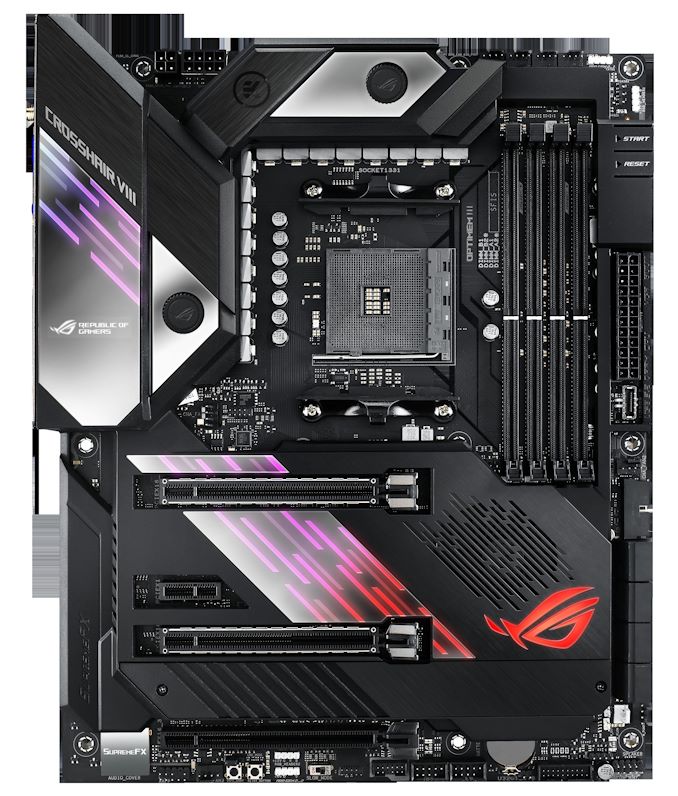The AMD X570 Motherboard Overview: Over 35+ Motherboards Analyzed
by Gavin Bonshor on July 9, 2019 8:00 AM ESTASUS ROG Crosshair VIII Formula
The ASUS ROG X570 Crosshair VIII Formula represents its flagship X570 entry onto the market with some very notable features, including a revamped design with a strong focus on performance, and ROG themed aesthetics. First of all, the ROG Crosshair VIII Formula uses EKWB heatsinks which can be connected to a custom water cooling loop for better power delivery temperatures, or as passive cooled. This has been seen on numerous iterations of its Maximus Formula boards created for Intel chipsets. This marks a shifting tide where ASUS seem to have confidence in AMD and the ability of its 7nm Ryzen 3000 processors, by opting for such a premium model for the X570 chipset.
One of the main focal points of the X570 chipset is its native PCIe 4.0 support. The ASUS ROG Crosshair VIII Formula has three-full length PCIe 4.0 slots operating at x16, x8/x8, and x8/x8/x4, with the final x4 coming from the chipset. This allows users to use two-way NVIDIA SLI and two-way AMD Crossfire multi-graphics card configurations. For add-on cards, a single PCIe 4.0 x1 slot is also present. There are also four DDR4 memory slots with a maximum supported capacity of up to 128 GB. Also included are a LiveDash OLED screen, a full metal backplate for a more rigid frame, and ROG armor across the majority of the PCB; not to forget about the swathe of RGB LED zones and the integrated fan within the chipset heatsink. On the rear of the board is a metal backplate which adds reinforcement to keep the board's structure intact.
On the componentry, the Crosshair VIII Formula uses a premium controller set with the most notable inclusions coming on the networking side. An Aquantia AQC111 5 GbE controller with a secondary Intel I211AT gigabit chip offers users dual LAN, but more impressively, ASUS has jumped onto the Wi-Fi 6 bandwagon by including the new Intel AX200 2x2 Wi-Fi adapter. The onboard audio is controlled by the Realtek SupremeFX S1220 HD audio codec. On the rear panel is a wide array of connections including seven USB 3.1 G2 Type-A, one USB 3.1 G2 Type-C, and four USB 3.1 G1 Type-A ports. Users can add to this with one USB 3.1 G2, two USB 3.1 G1 and two USB 2.0 front panel headers, with the USB 3.1 G2 offering one additional port, and the rest each offering an additional two ports per header.
The ASUS ROG X570 Crosshair VIII Formula is a mixture of premium controllers, quality features, and classic Formula aesthetics due to the implementation of an EKWB water block to keep the power delivery cool. This not only adds extra weight to the board but also cost and that is represented with an MSRP of $700.












225 Comments
View All Comments
Supercell99 - Tuesday, July 9, 2019 - link
I also expected benchmarks and a naked woman serving me a beer.haukionkannel - Wednesday, July 10, 2019 - link
You did not get that? That is really strange... I was sure that that was the basic service in here!;)
Gastec - Wednesday, July 10, 2019 - link
I had a dream last night about a woman, she was serving me...benchmarks :)Duncan Macdonald - Tuesday, July 9, 2019 - link
Why is the DDR4 memory speed being shown as a feature of the chipset? The memory is directly driven by the CPU not the chipset and as such the memory speed is independent of the chipset.Dug - Tuesday, July 9, 2019 - link
The motherboard still has work to do and is what supports the faster speed memory. Just because the cpu allows it, doesn't mean it will work without the correct chipset.thomasg - Tuesday, July 9, 2019 - link
The chipset has nothing to do with it, it has no relation to RAM clock and is exclusively driven by the PCIe clock, which is unrelated.The mainboard itself has the traces and therefore the manufacturer is expected to provide appropriate timing sequences to load into the CPU, which again, is not done on the chipset.
There's no reason a mainboard manufacturer couldn't support faster RAM on any older, compatible board (provided they do a firmware update and the board is designed well enough), a chipset upgrade is not required.
Death666Angel - Wednesday, July 10, 2019 - link
"the board is designed well enough" There is the catch. It might be that Ryzen being the first of its kind meant that many 3xx boards were designed poorly.First test I've seen is TPUs R9 3900x on a ASUS Prime B350 Plus which they claim ran at 3200CL14, but only after setting it to 2666MHz first and letting it train the memory. But it's an encouraging result.
Dug - Tuesday, July 9, 2019 - link
I'm interested in seeing what coolers will fit on the mITX boards. Specifically ASRock X570 Phantom Gaming-ITX TB3.It looks like some of these boards might be limited due to high heatsinks and fans on the motherboards.
Mikewind Dale - Tuesday, July 9, 2019 - link
Could we please have a comparison table? 35 pages is too many read. It would be useful to have a comparison table so that I can narrow down the several motherboards I am interested in, and then compare their prices.halcyon - Tuesday, July 9, 2019 - link
A summary table of features would indeed be very helpful. Way too many boards and pages...